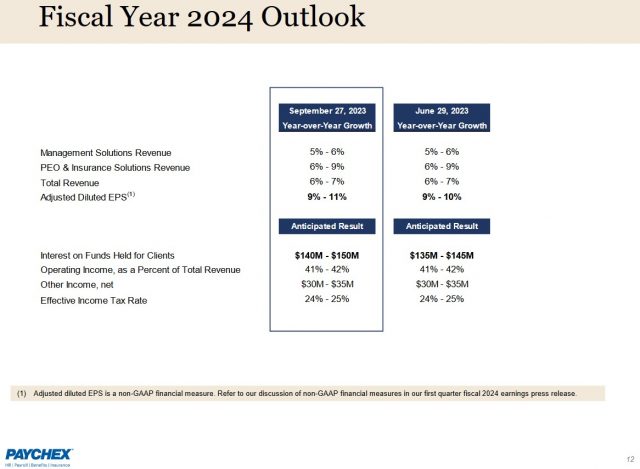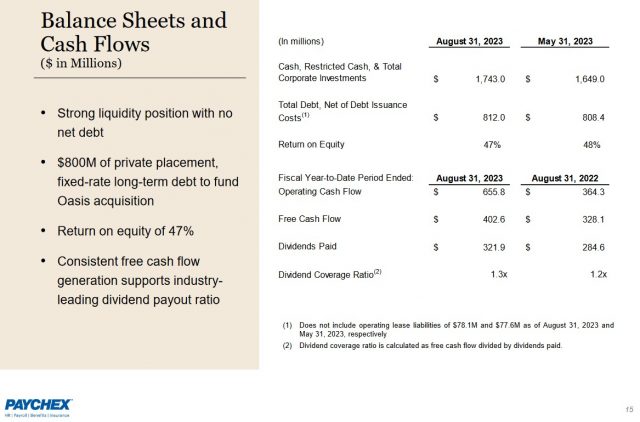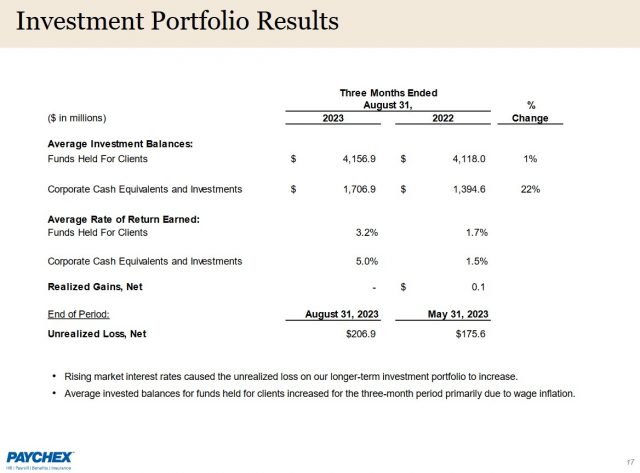Contents

I last reviewed Paychex (PAYX) in this June 30 post at which time I determined shares were attractively valued. This was encouraging considering that for the past several months I struggled to identify fairly or attractively valued high-quality companies.
Fortunately, the valuation pendulum has swung significantly of late thus presenting investors with a larger pool of fairly or attractively valued high-quality companies.
Now that PAYX has released its Q1 2024 results and revised FY2024 outlook on September 27, I briefly revisit low-risk PAYX to determine if it remains attractively valued.
Business Overview
A very high-level overview is accessible on the company's website. Part 1 of the FY2023 Form 10-K, however, provides a comprehensive overview of the company.
Recent Acquisition
In Q1, PAYX acquired a small company that purchases outstanding accounts receivable of their customers under nonrecourse arrangements. This acquisition is a good strategic fit with Paychex Advance; PAYX acquired Advance Partners several years ago to expand its product offering to include the purchase of accounts receivable for temporary staffing clients.
This acquisition will provide an opportunity for PAYX's small business clients to manage working capital challenges.
It is not anticipated to have a material impact on PAYX's FY2024 financial results.
Financial Review
Q1 2024 Results
PAYX's Q1 results and revised FY2024 outlook are provided in its Form 8-K and Earnings Presentation.
On the Q1 earnings call, management stated:
'Employment levels within our client base have remained stable. Small businesses, which are central to the U.S. economy continue to show their resiliency.
Our small business employment watch has shown that small businesses continue to add workers at sustained but modest rates. Also the trend in wages has shown some cooling and wage growth consistent with overall inflation.
Our data indicates a continued stable macro environment for small and mid-sized businesses.
We continue to monitor our leading indicators and are prepared to take appropriate actions to navigate any changes. But again, at this time, we don't see any material change to the macro environment.'
On August 31, 2023, PAYX had liabilities totalling ~$2.884B. This excludes ~$5.678B of client fund obligations and $51 million of deferred revenue (client funds received BEFORE services are provided).
On the assets side of the Balance Sheet, PAYX had ~$3.568B of current assets; this excludes $49.8 million of restricted cash.
PAYX's current assets before funds held for clients and restricted cash were ~$0.684B greater than its TOTAL liabilities (excluding client fund obligations and deferred revenue).
Cash flow from operations in Q1 was ~$0.656B. If we deduct ~$38.7 million in property and equipment purchases, we get Free Cash Flow (FCF) of ~$0.617B.
PAYX benefits from having client funds on deposit from which it can generate additional income. A rising interest rate environment benefits PAYX's short-term investments as seen from the average rate of returns reflected below. The rising rates, however, harm the longer-term component of the investment portfolio. PAYX incurred a ~$0.207B unrealized net loss on a mark-to-market basis.
FY2024 Outlook
When PAYX released its FY2024 outlook in June, the outlook took into account some uncertainty surrounding future interest rate changes. Management stated it would have better visibility into the remaining quarters as the year progressed, and therefore, quarterly adjustments were likely.
Management has now raised its FY2024 adjusted diluted EPS and Interest on Funds Held for Clients metrics.

Source: PAYX - Q1 2024 Earnings Presentation - September 27, 2023
Risk Assessment
No rating agency rates PAYX's debt. PAYX's financial position, however, is strong.
On March 13, 2019, PAYX completed the private placement of Senior Notes, Series A in an aggregate principal amount of $0.4B due on March 13, 2026, and Senior Notes, Series B in an aggregate principal amount of $0.4B due on March 13, 2029.

Proceeds from the Notes were used to pay off $0.8B in short-term borrowings under its JP Morgan credit facilities used to temporarily finance the Oasis acquisition; Oasis was the US's largest privately-owned professional employer organization (PEO) and an industry leader in providing human resources outsourcing services.
The credit arrangements PAYX negotiated in connection with the acquisition of Oasis Outsourcing Group Holdings, L.P., contain covenants that include restrictions regarding the incurrence of liens and indebtedness, substantial changes in the general nature of our business and our subsidiaries (taken as a whole), certain merger transactions, certain sales of assets and other matters, all subject to certain exceptions. The Agreement also contains financial covenants which are reviewed for compliance every quarter. These financial covenants require PAYX not to exceed a maximum leverage ratio of 3.5:1.0 and a minimum interest coverage ratio of 2.0:1.0. In addition, certain indebtedness may not exceed 20% of PAYX's consolidated stockholders’ equity.
Details of PAYX's financing arrangements commence on page 29 in the FY2023 Form 10-K.
Dividends and Dividend Yield
When I wrote my June 30 post, shares were trading at $109.33 and the $0.89 quarterly dividend provided investors with a ~3.26% forward dividend yield.
PAYX distributed its second consecutive $0.89 quarterly dividend on August 24. The third will be distributed in late November. There is a reasonable probability of an increase to at least $0.97 when PAYX declares a dividend in late April 2024. With shares currently trading at ~$116.50, the forward dividend is ~$3.72 ((2 x $0.89) + (2 x $0.97)) and the forward dividend yield is ~3.2%.
The weighted average number of diluted shares outstanding (in millions rounded) is 363, 365, 366, 365, 363, 363, 362, 362, 361, 362, 363, and 362.3 in FY2012 - FY2023 and 362.8 in Q1 2024.
PAYX maintains a program to repurchase up to $0.4B of common stock, with authorization expiring on January 31, 2024. The purpose of this program is to manage common stock dilution. Much like many other companies, PAYX issues shares under its employee compensation structure. This explains why there is very little change in the weighted average number of shares outstanding despite the repurchase of shares outstanding.
PAYX repurchased no shares in Q1 2024 and FY2023; $327.1 million remains available for share repurchases in total under the program.
In comparison, PAYX repurchased:
- 1.2 million shares for a total of $145.2 million in FY2022;
- 1.7 million shares for a total of $155.7 million at an average price of $90.83 in FY2021; and
- 2 million shares for a total of $171.9 million at an average price of $84.68 in FY2020.
Valuation
PAYX's FY2012 - FY2022 diluted PE levels are 20.19, 28.28, 26.08, 26.31, 28.32, 29.34, 23.44, 28.54, 31.80, 38.78, and 28.53.
I reference my June 30 post in which I provide PAYX's valuation at the time of prior reviews. I do, however, provide PAYX's valuation at the time of my most recent prior review for ease of comparison.
At the time of my June 30 post, I noted that PAYX generated $4.30 in diluted EPS and $4.27 in adjusted diluted EPS in FY2023. With shares trading at $109.33, the diluted PE was ~25.4 and the adjusted diluted PE was ~25.6.
The FY2024 outlook called for a 9% - 10% increase in adjusted diluted EPS. Using the 9.5% mid-point, I estimated a ~$4.68 FY2024 adjusted diluted EPS. With shares trading at $109.33, the forward-adjusted diluted PE was ~23.4.
The forward adjusted diluted PE levels based on the currently available broker estimates were:
- FY2024 - 20 brokers - mean of $4.65 and low/high of $4.35 - $4.71. Using the mean estimate, the forward adjusted diluted PE was ~23.5.
- FY2025 - 18 brokers - mean of $4.97 and low/high of $4.86 - $5.11. Using the mean estimate, the forward adjusted diluted PE was ~22.
PAYX generated $1.14 of adjusted diluted EPS in Q1 and management's FY2024 outlook now calls for 9% - 11% growth from FY2023's $4.27 adjusted diluted EPS. Using the 10% mid-point, PAYX's FY2024 adjusted diluted EPS is expected to be ~$4.70. Using the current ~$116.50 share price, PAYX's forward adjusted diluted PE is ~24.8.
The following are the forward-adjusted diluted PE levels using current broker estimates.
- FY2024 - 19 brokers - mean of $4.70 and low/high of $4.60 - $4.75. Using the mean estimate, the forward adjusted diluted PE is ~24.8.
- FY2025 - 18 brokers - mean of $5.01 and low/high of $4.91 - $5.15. Using the mean estimate, the forward adjusted diluted PE is ~23.3.
- FY2026 - 6 brokers - mean of $5.39 and low/high of $5.30 - $5.48. Using the mean estimate, the forward adjusted diluted PE is ~21.6.
Only 6 brokers have provided FY2026 earnings estimates. I, therefore, place little reliance on these estimates when looking at PAYX's forward valuation.
Final Thoughts
My long-term outlook for PAYX is unchanged from that expressed in my June 30 post.
It continues to benefit from regulatory tailwinds that are increasing the demand for retirement solutions and a greater need for employee retention tax credit services.
PAYX's primary customer base consists of small to mid-sized (SMB) businesses. This market has been surprisingly resilient given economic headwinds. Whether this continues remains to be seen.
Having said this, PAYX has weathered economic downturns in its history. Looking at its conservative balance sheet and ability to generate strong FCF, I remain confident PAYX would be able to weather future economic downturns.
I have been a PAYX shareholder since July 8, 2009, and have periodically added to my exposure. Based on my current analysis, low-risk Paychex remains attractively valued. I am, however, currently satisfied with merely increasing my exposure (721 shares consisting of 284 and 437 shares in a 'Core' and a 'Side' account in the FFJ Portfolio, respectively) through the automatic reinvestment of dividend income.
I wish you much success on your journey to financial freedom!
Note: Please send any feedback, corrections, or questions to [email protected].
Disclosure: I am long PAYX.
Disclaimer: I do not know your circumstances and do not provide individualized advice or recommendations. I encourage you to make investment decisions by conducting your own research and due diligence. Consult your financial advisor about your specific situation.
I wrote this article myself and it expresses my own opinions. I do not receive compensation for it and have no business relationship with any company mentioned in this article.



